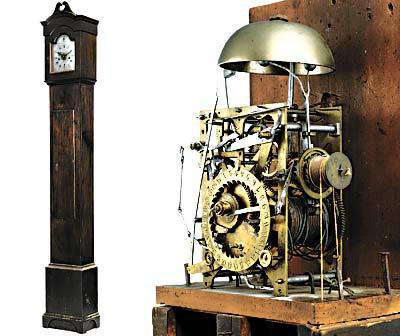Excitement Builds Over Dominy Clock at Sotheby’s

A tall-case alarm clock made by Nathaniel Dominy IV in East Hampton in 1788 will be auctioned in a sale taking place at Sotheby’s tomorrow and Saturday. The clock is thought to be the first alarm clock that the artisan made and is rare for early American clockmakers, who often imported their clockworks from Europe instead of crafting them themselves.
The auction lot, from the estate of Henry V. Williams of Long Island, is generating quite a bit of interest among local historians as well as national Americana experts and enthusiasts, with mentions in many of the trade journals.
Richard Barons, the director of the East Hampton Historical Society, said last week that he thought the clock was “positively beautiful” and in excellent condition for an object with its original finish. “There hasn’t been anything like it sold at auction for 45 years,” he said, although some similar items may have exchanged hands privately.
Although the clock’s provenance can be traced back to the mid-19th century, it appears that not much is known about its early life. The clock is in Charles Hummel’s book “With Hammer In Hand: The Dominy Craftsmen of East Hampton,” but because it was not in the shop’s logbooks that remain, no other information is currently available.
Robert Hefner of Amagansett, an architectural historian, said the list of known owners of the clock in later years includes a name from an East Hampton family. Asa O. Jones, recorded as being from Newport News, Va., was listed in the “East Hampton History and Genealogies” book written by Jeannette Rattray. The address given was a house on Newtown Lane built by the Jones family. It appeared that Jones also had a store on Newtown Lane where Scoop Beach is now. Mr. Jones is recorded as having the clock around 1857. “I imagine one could trace it back further in the Jones family,” he said. “His ancestor presumably would have had it before 1857, either through his father, Edward Jones, and his family or someone who married into the family.”
Among those who are awaiting the sale are Glenn Purcell and Charles Keller, two devoted and prolific collectors of Dominy objects who have become experts in identifying and researching objects that have emerged in recent years. Mr. Purcell said on Friday that Asa Jones was related to the Bakers, Hunttings and the Millers. The two other two clocks made in the Dominy shop in 1788 were made for Thomas Baker and William Huntting. The clock made in 1788 at Sotheby's was never entered in the logs. “This one is a puzzlement.” While it was not unusual to omit objects from the logbook if they were paid for in cash, it was unusual, he said, for such a significant piece not to be noted in the shop’s logs.
“We’re definitely excited,” Mr. Purcell said on Friday. “It’s a very special clock.” While Nathaniel Dominy IV made the elaborate works, he said it was Nathaniel V who carved the simple, Shaker-like case. They have registered to bid on the clock and hope “to bring it home to East Hampton.” Mr. Purcell said that the market for early American furniture was down, but for clock collectors, this object could be worth a lot of money. “Aggressive collectors are not affected by the economy.”
He added that he had been in contact with Mr. Hummel, who has become a friend over the years as each confers with the other over his discoveries. Mr. Purcell said Mr. Hummel told him that he has received some 50 calls from all over the country regarding the clock and its imminent sale. The clock is in Mr. Hummel’s book on pages 284 to 286.
Not only is the clock in superior condition, it is considered a “masterpiece of his workshop,” according to Sotheby’s. The catalog describes it further: The minute hand is made of a series of arches and the hour hand has a void that serves as the alarm indicator. The face is pewter. The clock has several inscriptions including the date and “Time! OH! HOW PRECIOUS” on the front and some rather existential musings — “Where, oh! Where shall I be when this clock / is worn out?” on the back of the dial.
